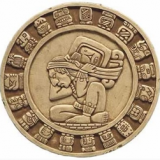East Indian Gemstone Jewelry: Remedy for Shani – Saturn
Gemstones and jewelry based on Vedic astrological system can balance the effects of Saturn. The persona and reputation of Saturn almost eclipses that of all other planets combined. “Lord of time”, “the terrible”, “end bringer” are just a few of the epitaphs that have described him through the ages. It is said all other planets and even the gods themselves break into a panic when Saturn is nearby.
Known to be tall, emaciated and lame he represents all that is inexorable of life and time itself. His cruelty and harshness strike fear into even those who worship him. The gods themselves do not escape the bounds of his wrath for as the ruler of time, all are within his grasp.
In Indian Vedic Astrology, Saturn is a bringer of misfortune and bereavements and for those who seek to avoid this and other such calamities Jyotish has provided us with upayas which the dark lord finds pleasing and when used may save us from his gaze. This particular article will focus on the gemstone remedy for Saturn but there are other types of upayas, which you should seek out if you are particularly afflicted.
SATURN
Saturn is always associated with the number seven and the color black. He is known as the supreme terrifier and all beings fear him. Saturn is known to be tall with prominent veins, brown eyes, large teeth and nails, long limbs, sunken stomach, a long beard, and a gaze that is always directed downward.
Saturn rules the nerves and the sinew of the human body and is also associated with the legs. He is known to bring restrictions in life. Slowness is always associated with Saturn and wherever he falls in your chart progress will come very slow and haltingly over a long period of time.
Saturn natives usually have a preference for the color black, are thin, villainous, short, dangerous, without wisdom and seen as eccentric or somehow outside the normal strata of society. Old people or people who deal with old things are considered Saturnian. As are historians, miners, drillers, laborers, prisoners, the homeless or anybody else living on the peripheral of things or considered an “outsider”.
The Black Crow is a very common representative of Saturn. Other animal familiars are the Raven, Vultures and the Elephant. Black animals in general are associated with Saturn and to feed one is considered pleasing to him and to help alleviate his wrath.
The traditional foods for Saturn are Sesame Seeds or the Black Gram. He also has association with Violets (the flower) and all trees considered useless and ugly.
NAMES:
Shani, Kona, Manda, Sani, Krishn, Surya Putr, Yama, Pangu, Sanaischara, Sauri, Kala and Chayasuta. Most texts refer to him as Shani.
ATTRIBUTES
Saturn represents selfishness, cunning and cruelty. Social spheres under his command are death, politics, poverty, lower classes, servants and outcasts. Oil and gas are usually associated with Saturn as are electronics and airplanes.
SATURN – A HISTORY
Saturn has been known by many names throughout history and his veneration goes back as far as written language itself. By understanding some of the past conceptions of Saturn through various civilizations and cultures we can come to a better understanding of what this force represents.
Traditional Indian representations of Saturn are usually in the form of Yama. Another name frequently associated with him was Mahakrura, which means “the exceedingly cruel”. These names are not too helpful however considering that the word Mahakrura is more of a description than a person and the fact that some sources claim Saturn is the brother of Yama rather than Yama himself.
Several cultures have shown deep veneration for Saturn throughout the ages including the Chaldeans and Babylonians. Saturn was considered the primary planet by both cultures and in Babylon and later in the Assyrian empire he was worshiped as Ninib, “God of the South”. Other references were made to him using the moniker Shamash which was known to be the “sun-star”. Thus, this would be the origin of the “dark star” or the “midnight sun” which has remained with us to this day. Alchemists have always referred to him as the “Black Sun” and in those circles he is still called that in modern times.
The Greeks also knew Saturn and worshipped him as the god Kronus which means, “he who gives the measures”, Chronos (Literally “time”) and Cronos, “the Crow God”.
Some sources attribute the Holy Stone of the Kaaba in Mecca to be representative of Hubal which was a Muslim name referring to Saturn.
ASSOCIATIONS
Saturn is known to rule the direction West where the Sun sets and darkness begins.
Saturn is known to be on the side of the Asuras or “demons”.
The 36th year is known as Saturn’s and in this year he brings to bear his full effects.
Capricorn and Aquarius are under the domain of Saturn and his exaltation is in Libra and his fall is in Aries.
Saturn is malefic in almost every placement.
Saturn is associated with Saturday and the number seven. Thus, there is some evidence pointing to July being a Saturnian association.
Black is the color traditionally associated with Saturn. Some sources assign the colors dark blue or bluish black to him as well. His metal is Iron and often the horseshoe is associated with Saturn and this may have been the reason that symbol has been passed down as a good luck charm.
Mercury and Venus are friendly toward Saturn while the Sun, Moon and Mars are enemies.
The element Air is considered to be under Saturn’s domain.
Saturn is always represented by the Vatta constitution in Ayurvedic medicine.
AREAS OF EFFECT TO LOOK FOR CHANGES
Adversities, captivity, prisons, difficulties, austerity, denials, barriers, bondage, danger, destruction, depression, discipline, dread, endless, eternity, inactivity, inertness, poverty, sorrows, emaciation, surrender, unattractiveness, undesirables, servants, laborers, frustration, humiliation, embarrassment, cycles, time, misery, misfortunes, work, slowness, perseverance, history, old age, introversion, bones, nerves, sinew, corpses, governments, indentures, debts, alien things, patience.
NOTES ON USING JEWELRY AND GEMSTONES BASED ON VEDIC ASTROLOGY TO INFLUENCE SATURN
There are certain times in particular when it might be helpful to wear a gemstone remedy for Saturn. Those times are listed below:
- Around the time of and during the “Saturn Return”. This is the time in which Saturn returns to the same position in your chart as it held during your birth. Most people will experience this several times in their life and it is usually a difficult and stressful experience.
- During the 36th year when Saturn brings about his full effects.
- During any dasha ruled by Saturn.
- During ones Sade Sati (literally “Seven and a half”) period. The Sade Sati period is a seven and one half year period of time in which Saturn moves through the three constellations or houses closest to the moon of your birth. Usually this is a difficult period filled with restrictions and disappointments.
The same cautions for Mars and the shadow planets also apply to Saturn. Sometimes a Vedic gemstone remedy brings about his negative effects as often as it reduces them. Therefore, any remedy should be used with caution with an eye toward observing events carefully afterward. If Saturnine events begin appearing then it is best to cease wearing the remedy and pursue one for another more beneficial planet, which might have a positive influence on Saturn. That said, wearing the Gemstone of Saturn can help to accentuate such things as longetivity, discipline, responsibility, hard work and dedication.
The gemstone associated with Saturn is Blue Sapphire almost exclusively but some refer to Amethyst as an alternative gem. The gem should be set in Iron if at all possible as this is considered Saturn’s metal.
With gemstones and jewerly using Vedic system Saturn’s gemstone remedy can help in the following areas besides the ones noted above: pain of all types, timidity, anxiety, fear, bad dreams, poverty, instability, shame, delays, humiliation, inhibition, loneliness, isolation, depression, stiffness, frugality, delays, melancholy and senility.






